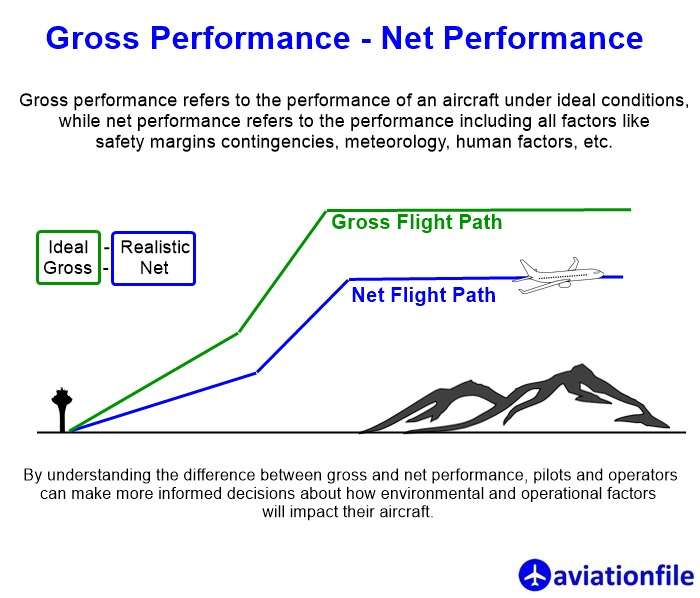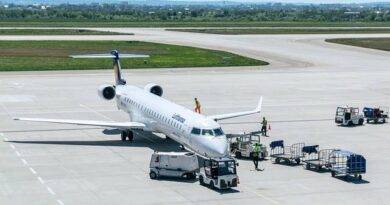Gross Performance vs. Net Performance in Aviation: Key Differences and Importance
In aviation, gross performance and net performance are two essential concepts that relate to the capability of an aircraft during various phases of flight, especially during takeoff, climb, and landing. These performance metrics help pilots and flight planners ensure that the aircraft operates safely and within its limits under various environmental and operational conditions.
Gross Performance
Gross performance refers to the ideal or theoretical performance of an aircraft under standard atmospheric conditions with a perfectly maintained aircraft, flown by an experienced pilot, without considering any real-world variables. GP figures are typically found in aircraft manuals and performance charts and represent the best possible performance under specified conditions.
Key characteristics:
- Assumes optimal conditions: These conditions include standard sea-level pressure, temperature (ISA – International Standard Atmosphere), no wind, and a properly maintained aircraft with no mechanical or operational deficiencies.
- No safety margins: Gross performance does not account for unforeseen circumstances such as changes in weather, pilot reaction time, mechanical failures, or operational variables like a less-than-perfect runway condition.
- Basis for calculations: Gross performance is used as a baseline to calculate other performance values, like net performance. It is essentially a perfect-world scenario.
For example, gross takeoff performance would be the shortest distance an aircraft could take off under perfect conditions with a fully functioning engine, ideal weather, and no additional obstacles or hazards.
Net Performance
Net performance represents the realistic or adjusted performance of an aircraft, accounting for a variety of factors that can affect flight in real-world conditions. It includes the application of safety margins to gross performance data, which ensures that the aircraft will have a buffer to handle unexpected circumstances during flight.
Key characteristics:
- Includes safety margins: Net performance typically reduces the gross performance by applying a percentage factor (often around 15-20%) to account for possible variables like pilot reaction time, minor equipment issues, environmental changes, or performance degradation due to age or condition of the aircraft.
- Real-world factors: Net performance considers less-than-ideal situations such as higher altitudes, non-standard temperatures, runway surface conditions, the presence of obstacles in the takeoff path, and non-optimal wind conditions.
- Operational use: Net performance is what pilots use for actual flight planning. It ensures a safe buffer over gross performance so that even under non-ideal conditions, the aircraft can safely complete its takeoff, climb, or landing.
For example, net takeoff performance accounts for reduced engine thrust on a hot day at a high-altitude airport and provides the actual distance needed to safely get airborne, considering these factors.
Differences Between Gross Performance and Net Performance
- Safety Margins: The primary difference is that gross performance represents the best-case scenario without any margins, while net performance includes built-in safety margins to ensure the aircraft operates safely in the real world.
- Ideal vs. Realistic: Gross performance is based on ideal, laboratory-like conditions, while net performance adjusts for realistic, variable conditions that can affect flight safety, such as weather, pilot response, or aircraft wear and tear.
- Usage in Flight Operations: Pilots and flight planners typically rely on net performance for actual operations, as it provides a more conservative and safer set of parameters. Gross performance is primarily a theoretical baseline that is adjusted to derive the net figures.

Importance in Aviation
- Safety Assurance: Net performance ensures that the aircraft can safely complete critical flight phases like takeoff, climb, and landing even under less-than-ideal conditions, which helps prevent accidents caused by underestimating the operational requirements.
- Regulatory Compliance: Aviation authorities like the FAA (Federal Aviation Administration) and EASA (European Union Aviation Safety Agency) mandate that flight performance calculations be based on net performance to ensure a safe margin is maintained. This is particularly crucial in emergency situations like an engine failure after takeoff.
- Flight Planning and Risk Management: By understanding the difference between gross and net performance, pilots and operators can make more informed decisions about how environmental and operational factors will impact their aircraft. For instance, knowing net performance helps in assessing whether an aircraft can clear obstacles during takeoff or if a particular runway is long enough for a safe landing.
In summary, gross performance provides an idealized baseline for how an aircraft could perform under perfect conditions, while net performance introduces safety margins and accounts for real-world variables, ensuring safer and more reliable flight operations. These concepts are crucial in aviation because they help maintain safety and operational efficiency under diverse conditions, safeguarding both the aircraft and its occupants.


